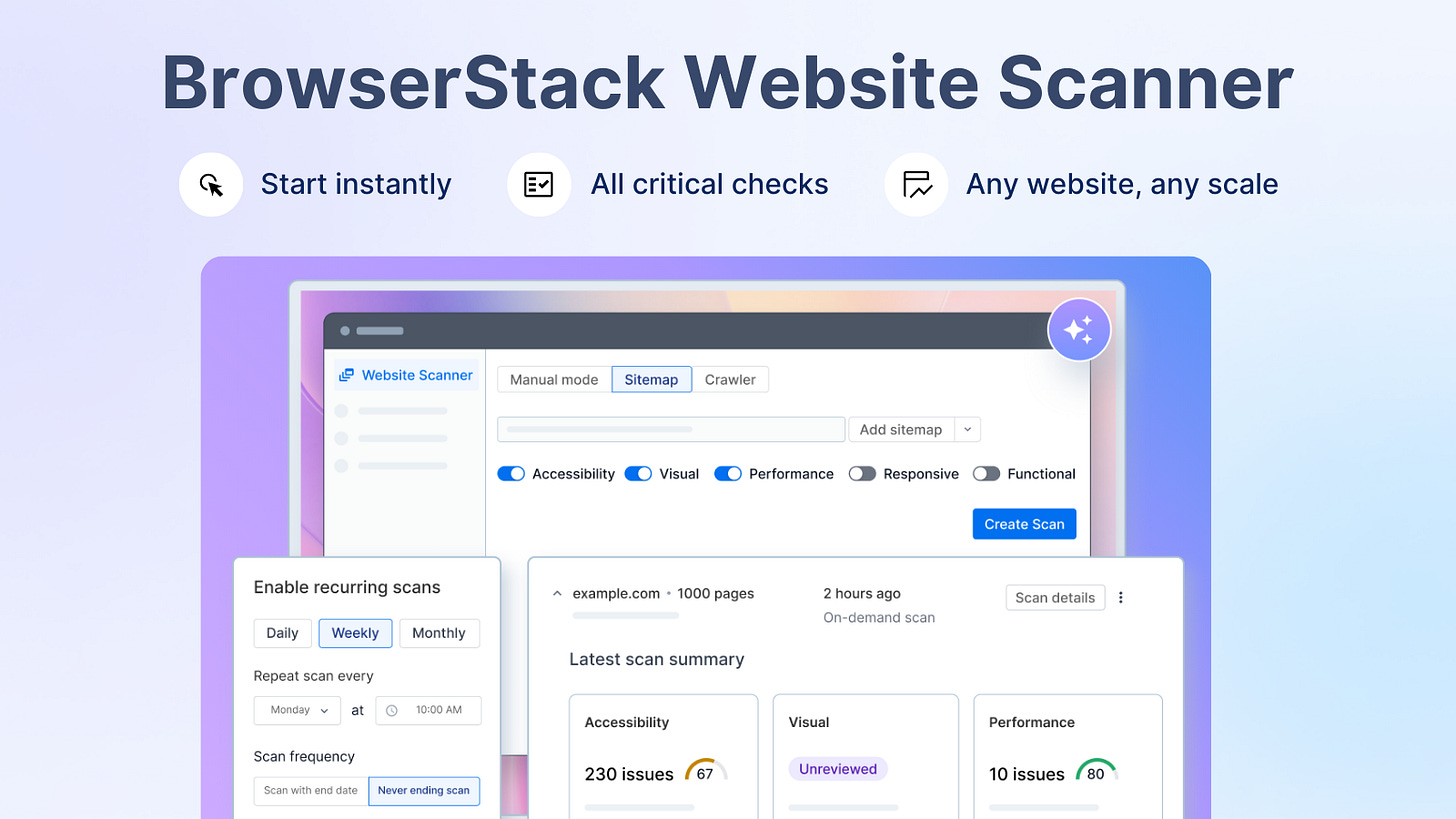Issue #188 : Software Testing Notes
Fun (and Sometimes Weird) Facts About QA That Nobody Told You
Hello there! 👋
Welcome to the 188th edition of Software Testing Notes, a weekly newsletter featuring must-read content on Software Testing. I hope this week has been good for you so far.
This week, we will explore:
Testers: Stop Competing with AI. Start Pairing with It
The Locust Attack: unleashing locust for scalable performance testing
Building a Robust Test Data Management Strategy for Automation
Fixing Flaky End-to-End Cypress Tests in CI Environments
Why You Should Test Your Page Without JavaScript
and more…
✨ Featured
All-in-One Website Scanner for QA Teams
Run full-site checks in minutes with BrowserStack Website Scanner. Catch accessibility issues, performance bottlenecks, broken links, visual glitches, and functional bugs—in one consolidated report. Simply add a sitemap or URL to scan thousands of pages at once. No coding required.
📚 Testing
Testers: Stop Competing with AI. Start Pairing with It by Rahul Parwal
Rahul Parwal makes a compelling argument for treating AI as a junior partner that amplifies your work. Using a quadrant model, the article shows where human creativity, judgment, and social skills shine, and where AI can accelerate repetitive or structured tasks.
Learning Faster: Deadlifts, Software Testing and Feedback Loops by Maria Kedemo
Maria Kedemo shares how What starts as a story about learning to deadlift became a thoughtful exploration of feedback loops in software testing.
Fun (and Sometimes Weird) Facts About QA That Nobody Told You by Charukshi Wijesinghe
This piece takes a lighthearted but thoughtful look at QA, tracing its roots back to factory floors and showing how it has evolved into something far more human than technical.
🔍 More Curated Articles
⚙️ Automation
Fixing Flaky End-to-End Cypress Tests in CI Environments by Adekola Olawale
Flaky tests are one of the biggest frustrations when running Cypress in CI, often passing locally but failing unpredictably in pipelines. Adekola Olawale digs into why that happens and walks through practical fixes.
Building a Robust Test Data Management Strategy for Automation by Abhishek Verma
It’s easy to blame flaky automation on the framework, but more often than not the real culprit is poor test data management. Abhishek Verma dives into practical fixes, from generating dynamic data with Faker and isolating accounts for parallel runs, to using mocks, database scripts, and CI/CD integration.
How Messy Playwright Tests Nearly Destroyed My Automation Project (And 7 Tips That Saved It) 🚀 by Shri Nithi
It’s tempting to think the power of an automation framework lies in its features, but this story by Shri Nithi shows how much structure really matters. If your automation feels slow, flaky, or unmanageable, you’ll find this post a reminder that organization is the real key to sustainable speed.
🔍 More Test Automation Articles
💨 Performance
Frontend Load Testing Against the Thundering Herd Effect by Irfan Mujagić
By simulating user sessions with k6 and tracking API call patterns, Irfan Mujagić demonstrates how easily a misconfigured React hook can trigger a Thundering Herd effect and overwhelm critical services.
The Locust Attack: unleashing locust for scalable performance testing by Prasad Patil
If your app suddenly takes off, will it hold up under the flood of traffic? This post makes the case for performance testing by revisiting Flipkart’s infamous Big Billion Day crash and then shows how Locust can simulate millions of virtual users to uncover bottlenecks before they reach production.
🔍 More Performance Testing Articles
🌞 Accessibility
Web Accessibility Testing – Are We There Yet? by Bhagya P.
Accessibility is finally getting the attention it deserves, but real-world practice still lags far behind the conversations. Bhagya P. highlights the gap and points out issues like overreliance on automation, inconsistent team approaches, and leaving accessibility until the end.
Why You Should Test Your Page Without JavaScript by Ilknur Eren
It’s easy to assume JavaScript will always be there, but network issues, blockers, or accessibility needs can leave users stranded when it fails. Ilknur Eren explores why testing without JavaScript matters, and how adding clear fallback messages and server-rendered content ensures your site stays resilient, accessible, and user-friendly.
🔍 More Accessibility Testing Articles
🛠️ Resources & Tools
Image Elf — A simple tool to generate placeholder images by just dragging on the screen to determine the size of the image, after which you can customize the final size and download as PNG or JPEG.
Browser MCP — An MCP server with Chrome extension that lets you use MCP to automate your browser so that AI applications can navigate the web, fill out forms, and more.
📝 List of Software Testers
Do you create content around Software Testing ? Submit yours blog details here and I will add it to the list.
🎁 Bonus Content
📌 OTHER INTERESTING STUFF
How Software Engineers Make Productive Decisions (without slowing the team down)
When the Job Search Becomes Impossible: Three Phases of Burnout
⭐ LAST WEEK'S MOST READ
Quality comes first – A review of “Deming’s Road to Continual Improvement” by Mike Harris
Don’t Just Test — Developing a QA’s Big Picture Mindset by JAY (翟彦明) ZHAI
😂 And Finally,
📨 Send Me Your Articles, Tutorials, Tools!
Wrote something? Send links via Direct Message on Twitter @TheTestingKit (details here). If you have any suggestions for improvement or corrections, feel free to reply to this email.
Thanks to everyone for subscribing and reading!
Happy Testing!
Pritesh(@priteshusdadiya)


